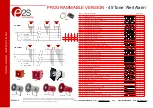
Installing the Device
2.4.3 Serial-to-Fiber Conversion: Loop Topology
1
2
3
1
RS232 Device
2
RUGGEDCOM RMC20
3
RS485 Device/Network
Figure 2.6
RS232 to RS485/422 Topology
Position
State
Notes
2
ON
Serial Conversion Mode
3
OFF
Half Duplex
4
OFF
Fiber repeat OFF
6
OFF
7
OFF
8
ON
9600 Baud
In this mode of operation, RS232 voltage levels are converted to the appropriate
RS485 or RS422 signalling levels depending on the DIP switch configuration. In this
mode of operation position 2 of the DIP switches must be in the ON position. The
topology depicted in
Figure 2.6, “RS232 to RS485/422 Topology”
illustrates an RS232
device, connected to an RS485 device or network. Since RS485 requires automatic
turn-around, position 3 must be set to the OFF state, and position 6 – 8 of the DIP
switches must reflect the proper operating baud rate.
Note
In this mode of operation, no isolation is provided between RS232 device and the
RS485/422 network – both devices share the same common terminal. It should be
noted that the common terminal on RS232 devices are connected to ground. In some
instances (i.e. when connecting to large RS485 networks), it may be preferential for
the user to leave the RS485/RS422 shield terminal unconnected to the RUGGEDCOM
RMC20 in this mode.
2.4.3
Serial-to-Fiber Conversion: Loop Topology
The following illustrates the optical loop topology that utilizes the RUGGEDCOM
RMC20 repeat mode function.
12
RUGGEDCOM RMC20
Installation Manual, 04/2021, C79000-G8976-1007-10
















































